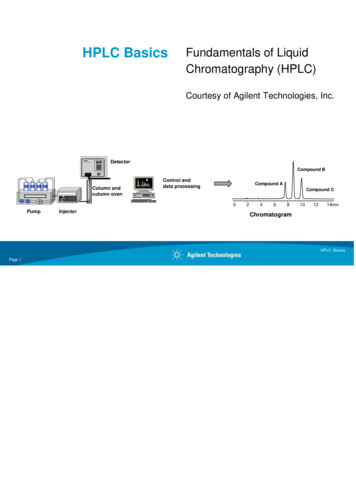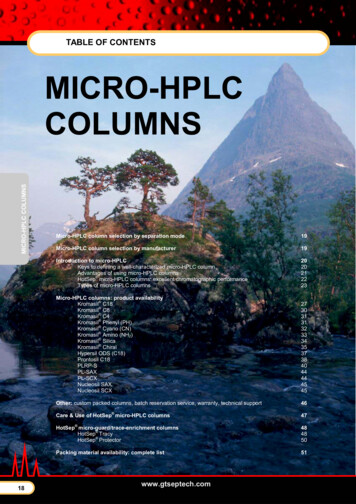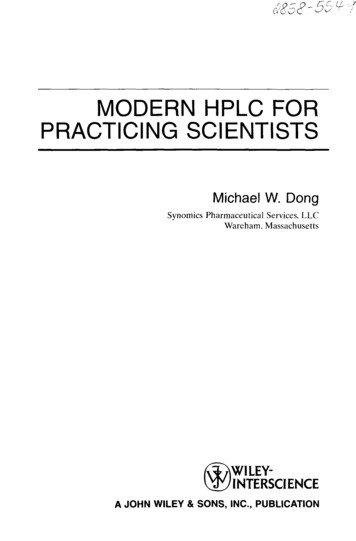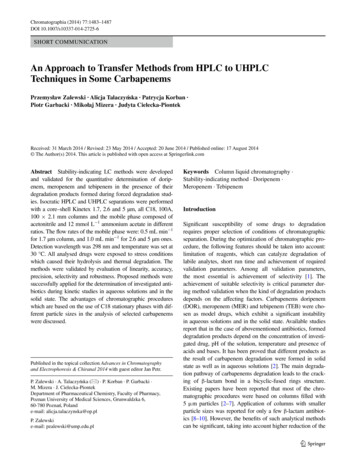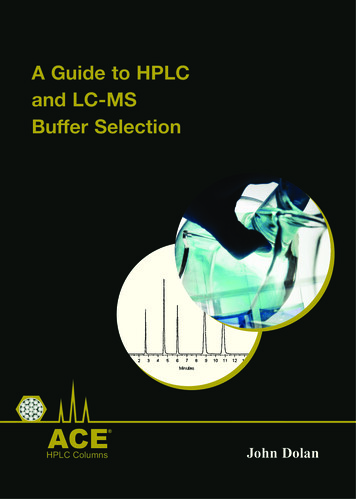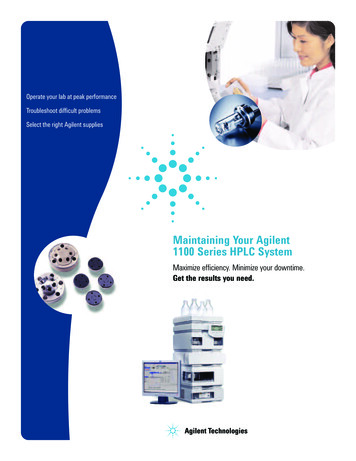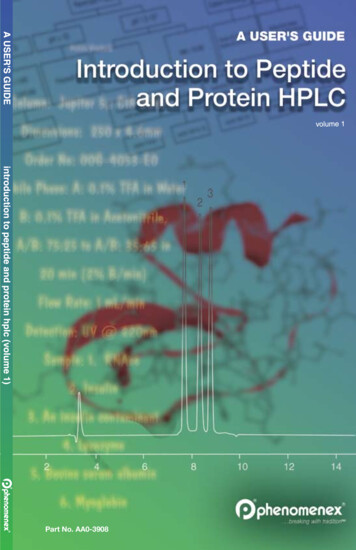
Transcription
Part No. AA0-3908
The Phenomenex Technical Assistance Center welcomes yourbioseparation questions. We are available to discuss yourspecific analytical needs.Please contact us at:www.phenomenex.comU.S.A.PUERTO RICO411 Madrid Avenue, Torrance, California 90501-1430Tel. (310) 212-0555Fax (310) 328-7768e-mail: info@phenomenex.com273 Sierra Morena, Suite #104, San Juan, Puerto Rico 00926Tel. (800) 541-HPLCFax (310) 328-7768e-mail: info@phenomenex.comFRANCEParc des Grillons, Bat.3, 60 Route de Sartrouville78232 Le Pecq Cedex, FranceTel. 01 30 09 21 10Fax 01 30 09 21 11e-mail: franceinfo@ phenomenex.comCANADA411 Madrid Avenue, Torrance, California 90501-1430Tel. (800) 543-3681Fax (310) 328-7768e-mail: info@phenomenex.comUNITED KINGDOMQueens Avenue, Hurdsfield Ind. Est., Macclesfield,Cheshire SK10 2BN, UKTel. 01625-501367Fax 01625-501796e-mail: ukinfo@ phenomenex.comIRELANDQueens Avenue, Hurdsfield Ind. Est., Macclesfield,Cheshire SK10 2BN, UKTel. 01 247 5405Fax 44 1625-501796e-mail: eireinfo@ phenomenex.comgermanyZeppelinstr. 5, 63741 Aschaffenburg, GermanyTel. 06021-58830-0Fax 06021-58830-11e-mail: anfrage@ phenomenex.comNEW ZEALANDP O Box 31-601 Milford 0741, North Shore City, New ZealandTel. 09-4780951Fax 09-4780952e-mail: info@ phenomenex.co.nzAUSTRALIAPO Box 4084 Lane Cove, NSW 2066, AustraliaTel. 02-9428-6444Fax 02-9428-6445e-mail: info@ phenomenex.com.auFor the distributor in your country, contact Phenomenex USA International Dept.E-mail: international@phenomenex.com
A User’s Guide:Introduction toPeptideandProtein HPLCTimothy P. Bradshaw, Ph.D.BioSep is a trademark of Phenomenex, Inc.Luna and Jupiter are registered trademark of Phenomenex, Inc. in the USA and other countries.Shodex is a registered trademark of Showa Denko K. K. Copyright Phenomenex 1998-2006, all rights reserved. No part of this booklet may be copiedwithout prior permission from Phenomenex, Inc. USA
A User's Guide to Peptide and Protein HPLCA User’s Guide: Introduction to Peptideand Protein HPLCPREFACEOver the past decade, tremendous progress has been made in the analysisof peptides and proteins by high performance liquid chromatography (HPLC).This phenomenon has been driven, in part, by a greater appreciation of the crucialroles these biomolecules play both in normal cell physiology and disease states.Indeed, peptides and proteins are now considered an important class of therapeutics used in treating diseases ranging from diabetes to cancer. The use of HPLC forpeptide and protein analysis has also exploded as a result of the myriad of novelcolumn supports and chemistries now commercially available.The first goal of this guidebook is to acquaint those new to peptide and proteinHPLC with some basic principles of the technique, especially as they relate tothese biomolecules. Some of the special features of peptides and proteins thatdistinguish them from other molecules and have relevance to their analysis arealso discussed. Secondly, I briefly discuss the five most common modes of HPLC(size-exclusion, ion-exchange, reversed phase, hydrophobic interaction, and affinitychromatography) used in peptide and protein analysis. I describe typical separation conditions and, in some cases, provide buffer compositions and conditionsfor initial attempts at chromatography. Hopefully, this type of information will proveuseful as one begins to design methods for individual application needs. After thisdiscussion, the attention turns to Small-Bore chromatography. This topic is particularly relevant today as researchers attempt to separate and identify the minutequantities of peptides and proteins typically contained in biological samples. Finally,in the last couple of sections, Phenomenex presents some thoughts on columnselection and beginning method development.The guidebook is obviously not a comprehensive treatment of the very broadsubject of peptide and protein HPLC. Instead, it is a limited overview that is meantto facilitate this analytical approach while dispelling its mystery as well as somepreconceived and often erroneous notions (such as the inevitable loss of bioactivity
A User's Guide to Peptide and Protein HPLCbelieved to be associated with certain modes of chromatography). I have reliedheavily on the wealth of information available in the literature, and the user isencouraged to consult the materials listed in the Sources and Suggested Readingsection. Of particular importance is the work of Mant and Hodges, which providesin-depth discussions from which I draw frequently. Their book, entitled HighPerformance Liquid Chromatography of Peptides and Proteins, provides a greatdeal of practical advice and may be regarded as "a teaching manual for both thenovice HPLC user as well as more experienced chromatographers".
A User's Guide to Peptide and Protein HPLCTABLE OF CONTENTSSection 1. General HPLC Theory and TerminologyBasic principlesTheoretical plates (N) and HETP (H)Two key events in HPLC separationRetention time and retention factorBand (peak) broadeningResolutionSection 2. Peptides and Proteins: General AspectsIntroductionBasis for separationSection 3. HPLC Techniques for the Analysis of Peptidesand ProteinsA. Size-Exclusion ChromatographyTheoryUse of denaturantsMobile phase, solid support and sample capacityLimitations of SECColumn cleaning, re-equilibration and storageB. Ion-Exchange ChromatographyMechanism and principlesStationary phase characteristicsIon-exchange supportsChoice of mode and general IEC conditionsSample application and column elutionColumn regeneration and storageC. Reversed Phase ChromatographyStationary phase and choice of columnTheory and mechanismStandard RPC conditionsIon-pairing reagents and pH effectsEffect of varying gradient, flow rate on separationsTemperature influencesRecovery of biological activityColumn cleaning and regeneration
A User's Guide to Peptide and Protein HPLCD. Hydrophobic Interaction ChromatographyStationary phasesTheoryTypical starting or first-run conditionsFactors affecting protein retentionColumn capacities and exclusion limitsColumn cleaning, regeneration and storageE. Affinity ChromatographyLigands and stationary phasesPrinciples and mechanism of separationCarrying out a runElution of bound speciesMobile phase effectsColumn capacityColumn regeneration, care and storageSection 4. Introduction to Small-Bore HPLCAdvantagesDisadvantagesSmall-Bore chromatography: instrumentation requirementsSpecial care considerationsSection 5. Choosing the Appropriate ChromatographicTechnique and ColumnProtein/peptide chromatography technique selection treeColumn selection guideBonded phaseColumn dimensionsParticle sizeSection 6. Column Technologies for BiochromatographyJupiter for Reversed Phase, Hydrophobic Interaction ChromatographyBioSep for Gel Filtration ChromatographyAppendicesA. References and suggested readingB. GlossaryAbout the Author
A User's Guide to Peptide and Protein HPLCSection 1.General HPLC Theory and TerminologySection 1 contains:Basic PrinciplesFor efficient use of HPLC to achieve the separation and purification of compounds, it is critical Basic Principlesthat one possess a basic understanding of the Theoretical Plates (N)physical parameters and theoretical considerand HETP (H)ations upon which the resolving power of themethod is based. Indeed, such knowledge is Two Key Events inoften essential in order for the researcher to deHPLC Separationvelop the best separation methods possible while Retention Time andsolving the various problems that can arise duringRetention Factorsthe practical use of HPLC. Before some basictheory of HPLC is discussed below, it should be Band (Peak) Broadeningnoted that undesirable chromatography can often Resolutionbe attributed to instrument limitations in additionto the stationary phase within the column itselfand/or the method employed for separation. For example, the valves, tubing, anddetector may hold relatively large volumes of mobile phase, thus contributing toband broadening through diffusion effects.In Figure 1, a number of important chromatographic terms and principles are illustrated. This chromatogram is typical of the elution profiles for two pure compounds,denoted as Peak A and Peak B. Here the concentration of the two solutes elutingfrom the column, based on the response of the detector (e.g., fluorescent, UV orradiochemical), is plotted against time. After injection onto an HPLC column, anysample components that do not interact with the stationary phase would elute attime to in the void volume (vo) which is characteristic for that column. This voidvolume represents both the interstitial volume between the particles of the bondedphase and the available volume within the particle pores themselves. The retentiontimes, tr(A) and tr(B), for the two sample components shown in Figure 1 are the timesfrom injection to the times of maximum concentration in the eluted peaks. Similarly,the retention volumes are the amounts of solvent required for their elution. We willdiscuss retention time in more detail later.
A User's Guide to Peptide and Protein HPLCFigure 1. Important chromatographic parameters, and how they are measured. tr(A) represents the retention time of peak A (measured in minutes); tr(B) is the retention time of peakB (measured in minutes); t is the difference in retention time of peaks A and B; to is theelution time of a sample component which is not retained on the column (has no interaction with the stationary phase), commonly called the void time of the column; t' r(A) is theadjusted retention time of for peak A (t'r(A) tr(A) - to); W(A) is the width at base of peak A(measured in minutes); and W(B) is the width at base of peak B. Reprinted with permissionfrom Reference 1.Theoretical Plates (N) and HETP (H)The number of theoretical plates (N) has traditionally been used as a measure ofcolumn efficiency. This value relates chromatographic separation to the theory ofdistillation. It may be visualized as a series of hypothetical layers within the columnin which a solute is in an equilibrium process of adsorption-desorption betweenthe two relevant phases.N 16(tr/W)2where tr is the retention time and W is the peak width at baseline.Generally, the measurement of peak width at half height has been found to be mostuseful, since it can be carried out on peaks not completely resolved, peaks thatexhibit tailing, or peaks that are otherwise asymmetrical in shape.N 5.54(tr /W½)2, where W½ is peak width at half heightThe value of N is a useful measure of the performance of a chromatographiccolumn, and in general the more theoretical plates, the better the column. Thenumber of theoretical plates can be calculated for any peak in a given separation,with each calculation resulting in a slightly different value. The value for N is to a
A User's Guide to Peptide and Protein HPLCfirst approximation, independent of retention time; however, it is proportional tocolumn length. Therefore, height equivalent to a theoretical plate (HETP) is thebetter measure of column efficiency since it allows for a comparison betweencolumns of different lengths.H HETP L/N where L is the length of the column, usually in mm.This value compares the extent that a given solute band has diffused during itsmigration down the column; thus efficient columns will have small H numbers. Asmall value for H is desirable such that as many plates as possible are presentwithin the column. For a typical HPLC column, well-packed with 5 µm particles,HETP or H values usually range from 0.01-0.03 mm.Two Key Events in HPLC SeparationThe separation of a mixture of peptides and proteins during an HPLC run is theculmination of two events that occur during the chromatographic process. The firstdeals with solute retention and has its foundation in the concept of mass distribution along the stationary phase. Specifically, as solutes move down the length ofthe column, carried by a controlled solvent flow rate that is delivered by the HPLCpumps, the individual components of the mixture interact with the mobile phaseand stationary phase to different extents. The second event involves band (or peak)broadening as the solutes travel down and through the chromatographic matrix.This dispersion is controlled by the diffusivity of the solutes and includes all thekinetic processes associated with the adsorption-desorption events combinedwith the molecular motion of the solute within the stationary phase. Together, theseeffects lead to band broadening which progressively increases during the transitthrough the column.Retention Time and Retention FactorThe retention of a solute is that time required for the compound to pass, followinginjection, from one end of the column through the other end of the column and intothe detector where it is monitored as an eluted peak. As stated above, in order forany two compounds to be resolved they must interact with the column matrix suchthat they are retained for distinct periods of time (tr), eluting in different solvent volumes (Vr). The retention factor (k’) is a measure of the degree of retention and can becalculated (assuming equal flow rates) by the following equation:k’ (Vr - Vo)/Vo (tr - to)/towhere k’ is the number of column volumes required to elute a particular solute (it is aunitless number); Vo and to represent the void volume and void time, respectively.
A User's Guide to Peptide and Protein HPLCThe retention factor is thus directly related to the partition coefficient of an analytebetween the mobile and stationary phases. A related concept is that of selectivity(α), which can be defined as the relative separation between adjacent solute peaks.This number is the ratio of the retention factors for the two peaks:α k’1/k’2Band (Peak) BroadeningBand broadening (or peak spreading) is a generally unavoidable consequenceof liquid chromatography. This undesirable phenomenon occurs as the soluteexperiences dilution during transit through the column. The extent of this effectis reflected in the column efficiency which, as discussed above, is illustrated bythe height equivalent to a theoretical plate (HETP). There are four major factors(Figure 2) that contribute to band broadening: (1) eddy diffusion, (2) longitudinaldiffusion from Brownian motion, (3) complications due to mass transfer, i.e., resistance to mass transfer in both the stationary phase and mobile phase, and (4)extra-column effects, particularly excessive dead volume within the system. Thesefactors contribute to band broadening by increasing the H number. The controlof these various forces that promote band broadening in HPLC represents one ofthe obvious challenges for the researcher. These processes can be partially offsetby using columns that are well-packed with uniform particles possessing narrow,uniform pore sizes. Moreover, peptides and proteins have relatively small molecularABCFINALBANDWIDTHSTARTMOBILE PHASEMASS TRANSFERLONGITUDINAL DIFFUSIONFROM BROWNIAN MOTIONSTAGNANT MOBILEPHASE MASS TRANSFEREDDY DIFFUSIONSTATIONARY PHASEMASS TRANSFERFigure 2. Various contributions to the molecular dispersion of a peak zone for a peptide solutewith porous HPLC sorbent. Reprinted with permission from Reference 2.
A User's Guide to Peptide and Protein HPLCdiffusivities in HPLC systems, therefore better column efficiencies can often beattained by careful attention to mass transfer kinetics. A more thorough discussion of this topic can be found from the recommended reading list at the end ofthis introductory guide.ResolutionResolution is defined as the extent between separation of two chromatographicpeaks. In practice one usually strives to have the best resolution possible within theconstraints of complexity of the mixture of solutes as well as the maximum practicallength of the column itself. Thus, resolution (Rs) can be described as a measure ofhow well a given HPLC column (and system) separates the two components.Rs difference in retention time / average peak base width 2(tr(B) - tr(A)) / (WA WB)For two symmetrical peaks, if the value for resolution (Rs) equals 1, then the peakswill be almost completely separated, having an overlap of only 2 %. Resolutionvalues greater than 1.5 indicate complete separation.Although its discussion is beyond the scope of this guide, resolution can also bedescribed in terms of an equation which includes three factors: the selectivity factorα, the capacity factor k’, and the plate number, N. Thus:Rs (selectivity factor) x (retention factor) x (column efficiency factor)Rs α k1 NEach of these three factors can be optimized independently, with selectivity playingthe most important role with respect to resolution. Column efficiency is secondin importance and, as described earlier, can be maximized by the use of longercolumns, by decreasing the particle size of the solid support, or by adjusting theflow rate. The retention factor typically does not play a major role in affectingresolution.10
Section 2.Peptides and Proteins:General AspectsIntroductionSection 2 contains: Introduction Basis for SeparationProteins are the most abundant biomoleculespresent in all living cells, contributing up tofifty percent of the cell’s dry weight. Proteinsserve a variety of purposes, including metabolic(e.g., enzymes), structural (e.g., collagen),transport (e.g., hemoglobin), and defense(e.g., antibodies) functions. These importantmacromolecules are made up of long chainpolymers of the basic building blocks calledamino acids. Almost all proteins are constructedentirely from the same set of 20 common aminoacids, linked in characteristic sequences whichimpart to them their specific functions.Figure 3 (next page) shows the 20 common amino acid building blocks of proteins.Amino acids are covalently coupled via peptide (amide) bonds to form the linearpeptide chain (Figure 4). Each amino acid has in common a carboxyl group and anamino group bonded "a primary carbon". They differ from each other by their sidechains (or R groups) which vary dramatically in structure, size, electric charge andsolubility in water. Thus, the properties of proteins and peptides are directly relatedto the primary sequence of amino acids from which they are derived, and whichwill be a major determinant in the type of chromatographic technique necessaryto achieve their separation and/or purification. The amino acids shown in Figure 3can be grouped into families based on the properties of the side chains. There arefour main families: (1) nonpolar or hydrophobic R groups, (2) polar but uncharged Rgroups, (3) negatively charged R groups found in acidic amino acids, and (4) positively charged R groups found in basic amino acids.Amino acids are ionizable in aqueous solution; those that have a single carboxylgroup and a single amino group exist at physiological pH (7.4) as the fully ionizedzwitterion. Furthermore, many peptides and proteins also contain ionizable acidicand basic side chains such that their charge and polarity are a function of the pH.Every protein, at a certain pH called the isoelectric pH, or isoelectric point (pI), willcontain an equal number of positive and negative charges, and thus will be electrically neutral. At this pH, the protein is in its least soluble state in aqueous solution.11
A User's Guide to Peptide and Protein HPLCFigure 3. Structural formulas of the 20 most common amino acids.12
A User's Guide to Peptide and Protein HPLCPeptide bonds absorb ultraviolet (UV) light strongly in the 200-220 nm range. Thisproperty explains why UV detection is routinely used for the identification andquantitation of peptides. Moreover, most proteins contain varying amounts of theamino acids tyrosine, tryptophan and phenylalanine, whose aromatic side chainsabsorb UV light in the 250-280 nm range. The presence of these residues allows forthe detection and quantitation of proteins at higher wavelengths, thereby minimizingthe background signal generated by mobile phases during HPLC.In this introductory guide, we will consider the HPLC separation of both proteinsand peptides. Although there is no explicit distinction between polypeptides andproteins, we will consider polypeptides to consist of 2-50 amino acids. As polypeptide chains grow toward 50 amino acids in size, they usually adopt particular threedimensional structures in aqueous solution and are called proteins. For example,bovine insulin (MW 5700) is formed from the disulfide linkage of two polypeptidescontaining 21 and 30 amino acids each.Figure 4. Peptide structural formula.It should be noted that conformation can dramatically influence the chromatography of peptides as well as proteins, and should be a consideration when selectingseparation modes and conditions. The potential for secondary structure increaseswith increasing chain length, and is particularly important in cyclic peptides. Forexample, cyclosporin A is a cyclic undecapeptide that is the primary immunosuppressive drug used in organ transplant patients. This unusual peptide adopts aconformation at 37 ºC such that strong intramolecular hydrogen bonds are formed,thereby yielding an extremely hydrophobic molecule requiring high concentrationsof organic solvent for elution in reversed phase HPLC. Similarly, some peptides mayinternalize hydrophobic residues to stabilize the folded structure in aqueous solution,giving rise to molecules that appear less hydrophobic in solution, and thus are moreweakly retained in reversed phase HPLC than their unfolded counterparts.13
A User's Guide to Peptide and Protein HPLCBasis for SeparationThe tremendous amount of structural diversity possible among peptides and proteins allows for the differences observed in their physical, chemical and functionalproperties. These differences in behavior also provide the molecular basis for theirseparation and/or purification by today’s modern HPLC methods. The peptideand protein properties that have been shown to be useful to this end include size,shape, charge, hydrophobicity, and function.The molecular weights of proteins vary widely from a couple of thousand daltonsupwards to several million, and can sometimes yield the most straightforward,effective approach to their separation. Besides total molecular weight, proteinsalso adopt specific tertiary structures which must also be considered in the use ofsize-exclusion chromatography to design successful separation methodologies.For example, a compact globular protein will exhibit an apparent molecular sizemuch smaller than its denatured, unfolded counterpart. Obviously, protein shapeis dramatically influenced by the chemical environment.The differing acid-base properties of both peptides and proteins discussed earlierfrequently becomes the basis for their separation and identification by HPLC. Thenet charge experienced by a given protein is greatly influenced by the pH of thesolution. A protein will be negatively charged at pH values above its pI, and positively charged at pH values below its pI. Ion-exchange chromatography exploitsthese differences in the acid-base behavior of peptides and proteins, and is oftenused as a separation step in their purification.Besides the number of charged groups that peptides and proteins contain, therelative hydrophobicity of the molecules is also an important consideration in theirchromatography. It is the interactions between peptides/proteins and hydrophobicstationary phases that provide the basis of reversed phase chromatography andhydrophobic interaction chromatography, two of the most widely used and powerfulmodes employed in HPLC applications today.Additionally, we have already described how the unique sequence of amino acidspresent in a protein determines its specific function. The binding interaction between active proteins and their substrates or target molecules is often exploitedin affinity chromatography, providing the researcher with another powerful, highlyselective technique for separation and/or purification.14
A User's Guide to Peptide and Protein HPLCSection 3.HPLC Techniques for the Analysis ofPeptides and ProteinsSection 3 contains: Size-ExclusionChromatography Ion-ExchangeChromatography Reversed PhaseChromatography Hydrophobic InteractionChromatography Affinity ChromatographyThe routine use of HPLC in the analysis of peptides and proteins is a relatively recent event;however, the basic separation mechanisms involved in the resolution of these molecules are verysimilar to those used in classical (gravity) chromatography.Below we examine the use of a number of themost widely used HPLC methods for achievingboth separation and purification of peptides andproteins. After spending some time describing thetheory and practical aspects of utilizing these various HPLC modes in the laboratory, later sectionswill include important considerations in developingseparation methods.A. Size-Exclusion Chromatography (SEC)One of the earliest realizations in analytical sciencewas the possibility of separating molecules byexploiting differences in their apparent molecular Theorysizes. Since the introduction of Sephadex in 1959, Use of Denaturantssize-exclusion chromatography (also referred to as Mobile Phase, Solidgel-filtration or gel-permeation chromatography)Support, andhas been a widely used laboratory tool in the sepaSample Capacityration of proteins. Because harsh elution conditionsare not required, size-exclusion chromatography Limitations of SEC(SEC) does not inactivate enzymes, and thus is Column Cleaning, routinely employed as an important step in theirRe-equilibration and purification. The widespread use of SEC can alsoStoragebe attributed to the speed, simplicity and versatilityof the method. The HPLC mode of this type of liquidchromatography became possible in the 1980’s only with the advent of semi-rigid(e.g., polystyrene) or rigid (e.g., silica) particles with uniform pores large enoughSection 3A contains:15
A User's Guide to Peptide and Protein HPLCto be entered by proteins. Besides its use for separating and/or purifying proteinsthat differ significantly in size, there are two other important utilities of size-exclusion chromatography. SEC can also be used to change the buffer environment ofa sample (as in the desalting of a protein before other studies or chromatographicprocedures) and, more importantly, as a means of estimating the molecular sizesand shapes of proteins.TheorySize-exclusion column packing materials consist of particles containing pores ofwell-defined size. As the mobile phase flows over and through these particles, itcarries along with it solutes which, depending on size, may flow into and out ofthe pores. Unlike other HPLC techniques, SEC does not depend on any selectiveinteraction with the stationary phase. Thus, if a mixture of proteins or peptides isapplied to a size-exclusion column that has been correctly packed with porousmaterial of a specific pore size, these molecules will be separated by differencesin their sizes, or more precisely, hydrodynamic volumes (defined by their Stokesradii) (Figure 5).Large, totally excluded analyteLarge, totally excluded analyteIntermediate, selectively retained analyteIntermediate, selectively retained analyteSmall, totally permeated analyteFigure 5a. Separation of Analytes in Gel-Filtration Chromatography.Figure 5b. Schematic representation of gel-filtration chromatography. Molecules of differentsize in the frame are separated according to size during migration through the gel-filtrationmatrix as shown in the middle and right frames.16
A User's Guide to Peptide and Protein HPLCSize-exclusion columns have published exclusion limits measured in daltons, andproteins whose molecular weights are larger than the exclusion limit are excluded(i.e., are too large to enter the pores) and elute in the void volume (Vo) of the column.The pores of a particle are differentially accessible to smaller proteins which thenmay elute after the void volume. The volume within the pores of the gel is calledthe internal volume (Vi), whereas the total permeation volume (Vt) of the column isdefined as the sum of the void volume and the internal volume:Vt Vo Vi (Vo here is the excluded volume)In ideal SEC, there is a linear relationship between the elution volume (Ve) of aprotein and the logarithm of its molecular size (actually its Stokes radius), suchthat it is possible to estimate (within 10 %) the molecular weights for a series ofproteins that elute between the void volume and the total permeation volume of agiven HPLC column. The elution volume (Ve) can be described by:Ve Vo KDVi, KD (Ve - Vo)(Vt - Vo)The distribution coefficient (KD) is a constant which describes the elution of solutes by SEC and which will be proportional to the logarithm of their molecularweights (MW). Plots of KD against log MW are typically linear between KD values of0.15-0.80. Calibration curves, from which the molecular weight of an individualprotein can be estimated, can also be constructed by plotting log MW vs. elutionvolume or retention time, KD (Figure 6). The linearity of the plots offers a measure ofthe range of protein molecular weights that can be accommodated by the column(i.e., the column quality), and generally the lower the slope of the curve, the better the resolution between proteins of different molecular weights. One importantreminder is that this approach to molecular weight determination is based on theassumption that the protein is globular and symmetrical in shape.17
A User's Guide to Peptide and Protein HPLCFigure 6. Molecular weight calibration curve using BioSep -SEC-3000.Moreover, the use of instruments capable of delivering accurate, reproducible flowrates is often essential for obtaining meaningful data from complex samples withthis mode of chromatography. Otherwise, peak identification based on retentiontimes alone becomes unreliable.Use of DenaturantsFor more accurate deter
A User's Guide to Peptide and Protein HPLC TABLE OF CONTENTS Section 1. General HPLC Theory and Terminology Basic principles Theoretical plates (N) and HETP (H) Two key events in HPLC separation Retention time and retention factor Band (peak) broadening Resolution Section 2. Peptides and Proteins: General Aspects Introduction Basis for .
